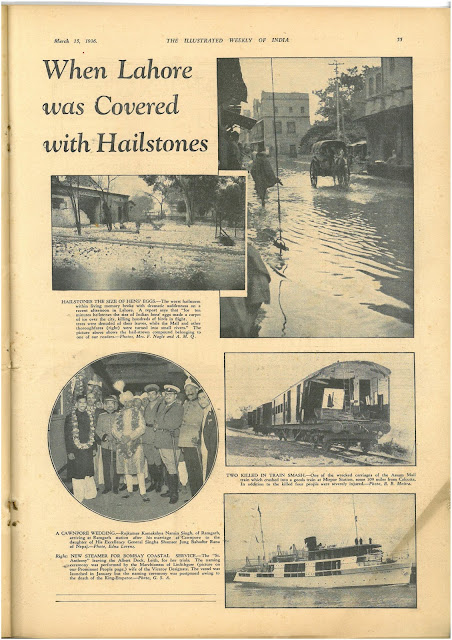I first came across the
Illustrated Weekly of India when researching the work of the wonderful photographer,
Homai Vyarawalla. Several of her iconic black and white pictures were published in the Mumbai based journal during the 1940's although in the early days they were included under her husband's name.
The Weekly as it was known by its devoted readers was first published in 1880 and for more than a century was one of the most popular English language publications in India.

Published in large format, it included high quality photography, travel and sports reportage, fiction, gossip, cartoons and several pages of advertising. Its many readers included students who used it to improve their command of English and to extend their vocabulary. Amongst others, the magazine was edited by award winning author
Khushwant Singh whose novel
Train To Pakistan is acknowledged as one of the best works about Partition. Sadly, the magazine closed in 1993 when due to intense competition from other titles, the parent company decided to end publication, preferring to concentrate on revitalising its newspapers.
After some searching on a variety of websites I managed to get hold of the 15th March 1936 edition of The Weekly. It is a fascinating record of life of the better off in the lead up to the Second World War and before independence and partition. As well as coverage of Indian news, there are articles on a rebellion in the Japanese army which included the murder of several government ministers, a travel piece on Mongolia and treasure hunting in the Seychelles. A piece on investment notes worrying developments in Europe, making reference to German re-occupation of the Rhineland. Coverage of sport is also prominent with a full page piece on The Art of Table Tennis, photographs of some very serious Indian cricketers about to tour England, a piece on hooliganism at a Calcutta cricket game and an illustrated Round the Sports World article. The latter item includes a reference to the Calcutta Inter-School sports for girls which included a balancing race requiring competitors to carry earthen pots on their heads. Exercise and deportment in one go.


As already mentioned this edition was published some years before independence and partition. This is reflected in the extensive coverage of all things British including an article on a royal visit to Canada and a news roundup under the heading Britain Week by Week. There is also an item on a hailstorm in the city of Lahore, later to become part of Pakistan, which reports "...for ten minutes hailstones the size of Indian hens' eggs made a carpet of ice in the city, killing hundreds of birds in flight..trees were denuded of their leaves and the Mall and other thoroughfares were turned into small rivers".
I especially like the advertising pages which are spread throughout the magazine rather than being gathered in a single place. Many of them are related to health, offering medicine, pills and advice on a range of ailments including headaches, kidney trouble, stomach and bowel troubles, painful piles (with a cream dispensed from a tube with a terrifyingly long sharp point), blood pressure and asthma which it seems could be cured in a mere ten minutes by taking something called Ephazone. There are also advertisements for various skin creams, hair dye, hair restorer, hair remover and other beauty products, different types of film for your camera and various household goods. I am especially interested in the advert for Yaffi's Hair Restorer which claims to ...cures baldness...gives tone and style to the most awkward head of hair...removes dandruff, prevents falling hair and gives an energising effect to the brain. Not only that It does not soil hat or pillow. Next time I am in Mumbai I will go in search of Mr. Yaffi's shop! A number of well known British brands advertised in The Weekly including Cow and Gate, Bisto, Brooke Bond, Pears and Lea and Perrins.


It was photography that led me to the
Illustrated Weekly of India and it was also a draw for the readers. As well as being able to enjoy high quality photographs each week, they were encouraged to submit their own pictures. Prizes were awarded for the best and this week's winner was a Mrs. Z. D. Basrai of Bombay for her picture entitled "Festival in Bali" featuring a Balinese dancer. And like all good magazines,
The Weekly contained what would today be known as a gossip page, reporting on the activities of film stars, royalty and politicians. This week's edition included the news that actress
Margaret Lockwood had been cast in a new film,
The Beloved Vagabond which was to star Maurice Chevalier. This famous and popular British actress, born in Karachi was to go on and make many more films including the Alfred Hitchcock directed
The Lady Vanishes.
The India Illustrated Weekly is a wonderful archive of a world that has largely disappeared. If any former readers of the magazine find their way to this post, they would be very welcome to share their memories of it in the comments below.






















